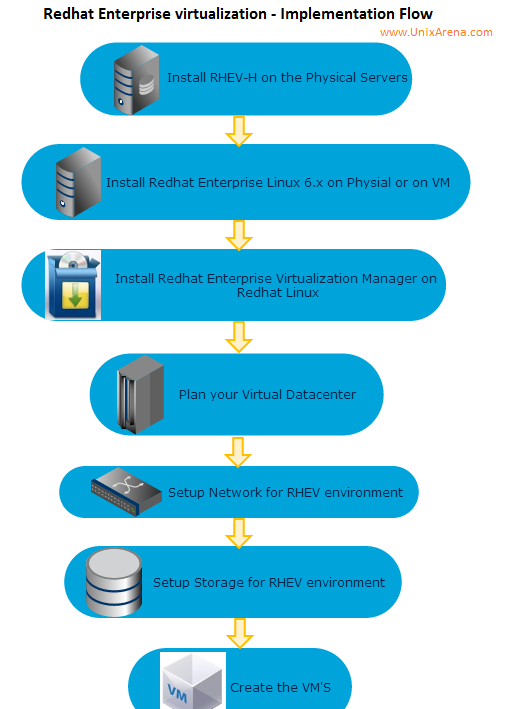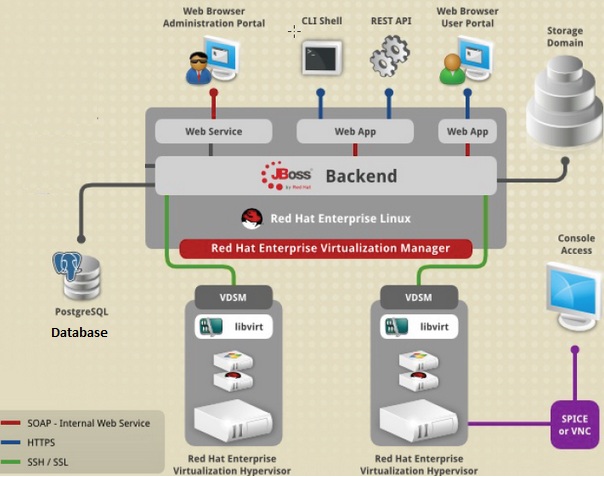Red Hat had played vital role on Linux revolution and they proved that Linux can be used on the enterprise computing. Today Red Hat is the world’s largest distributor of Linux. To reduce the infrastructure costs , all the companies are behind the virtualization. Companies like VMware,Citrix and Oracle are offerings enterprise virtualization products to accommodate different virtual guests. What about Redhat ? Are they have any product like VMware vSphere or Oracle VM for x86 ? Yes. They have their own enterprise virtualization product called Redhat Enterprise virtualization.
What are the best things about Redhat Enterprise virtualization ?
According to the redhat site,
- RHEV – Support for up to 160 logical CPUs and up to 2TB of memory per virtual machine (VM)
- Up to 95% to 140% performance gains for real-world enterprise workloads like SAP, Oracle, and Microsoft Exchange
- Consolidation ratios of 850+ VMs with enterprise workloads running on a single server
- Robust Microsoft Exchange performance and high I/O throughput in Oracle database workloads
- Supports oracle DB and IBM’s DB2
- Supports Microsoft’s IAAS and LAMP
- Compare to other vendors, RHEV’s TOC is very less.
- Better performance
What are the guest operating systems are supported on RHEV ?
- Red Hat Enterprise Linux 3 (32 bit and 64 bit)
- Red Hat Enterprise Linux 4 (32 bit and 64 bit)
- Red Hat Enterprise Linux 5 (32 bit and 64 bit)
- Red Hat Enterprise Linux 6 (32 bit and 64 bit)
- Red Hat Enterprise Linux 7 (32 bit and 64 bit)
- Windows 7 (32 bit and 64 bit)
- Windows Server 2003 Service Pack 2 and newer (32 bit and 64 bit)
- Windows Server 2008 (32 bit and 64 bit)
- Windows Server 2008 R2 (64 bit only)
- Windows XP Service Pack 3 and newer (32 bit only)
Compare the Redhat enterprise virtualization components with VMware vSphere & Oracle VM
| RHEV | VMware vSphere | Oracle VM for x86 | Description |
| RHEV-H | VMware ESXi | Oracle VM server | Hypervisor(Bare-metal) |
| RHEV-M | VMware vCenter | Oracle VM Manager | Centralized Manager |
| Web Access ? Yes | Web Access ? Yes | Web Access ? Yes | User interface |
Redhat Enterprise virtualization – Implementation Workflow :
To implement Redhat enterprise virtualization, You need to install the RHEV-H hypervisor on the physical server. Then you need redhat enterprise Linux 6.x server to install the RHEV-M software. Since RHEV-M host is going to manage the entire RHEV environment, you need database to store the virtual objects and retrieve in quick time. RHEV-M provides option to connect external database as well. Once you have configured the redhat enterprise virtualization manger(RHEV-M), you can attach the RHEV-H node to it using the administrative web portal.Using this portal, you can setup the RHEV network and storage. Once you have done everything as mentioned in the workflow, you are good start creating the VM for use.
How the RHEV components are interconnected with each other ?
Redhat Enterprise virtualization manager(RHEV-M) is the central hub to manage the RHEV environment. All the RHEV-H hosts are attached to Manager. You can have database also withing RHEV-M box or external based on your environment requirement.
Hope this article may shed some light on Redhat Enterprise Virtualization. Many more to come about RHEV. Stay Tuned with UnixArena.
Thank you for visiting UnixArena.
The post Redhat Enterprise Virtualization – Overview appeared first on UnixArena.

